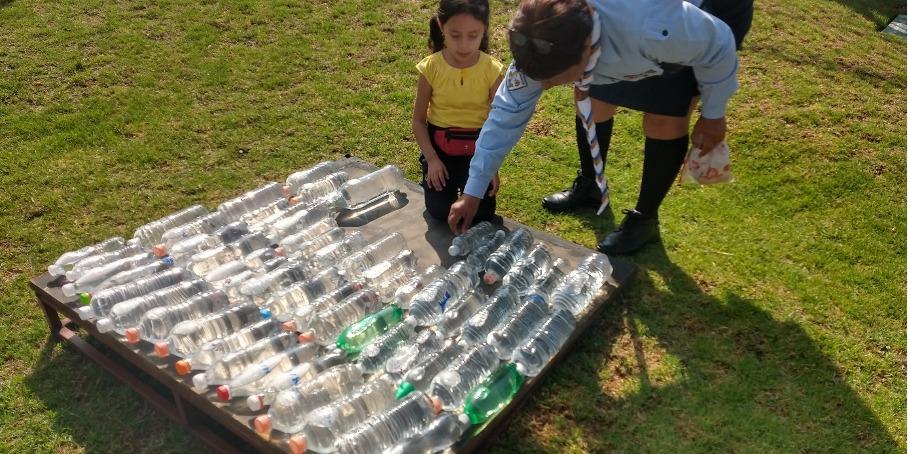Safety First
Before we begin, remember to protect yourself from the sun's rays, with a hat, sunscreen etc. Never look directly at the sun, not even using sunglasses.
- Fill the transparent plastic bottle three-quarters full with the water you want to disinfect (if it is turbid or murky, filter it first, as described in ‘additional activities’)..
- Close the bottle securely and shake it vigorously for 20 seconds.
- Fill the bottle to the top with more water, leaving space for expansion.
- Close the bottle tightly again, to prevent leaks.
- Find an outdoor area with direct sunlight and place the closed bottle on a surface exposed to the sun.
- Now you need to be patient. For partly cloudy days, wait 48 hours for the SODIS method to work its magic. On sunny days, you only need to wait 6 hours to achieve safe water.
Note
The SODIS method cannot be used on rainy days, as the absence of direct sunlight may compromise its effectiveness.
Evaluation
Explain how UV rays from the sun inactivate viruses and bacteria during the SODIS water treatment.
Theory
Benefits of the sun
The sun provides us with many vital functions. Keeping temperatures at an agreeable level is just one of them. We need the rays of the sun on our skin to produce enough vitamin D. But the sun is also important for our mental health, especially in northern countries, where sunlight is scarce for several months (people with depression can be fortified through light therapy). Or, the sun can disinfect drinking water.
An example is the SODIS method, a simple yet powerful water treatment technique. It relies on solar energy and transparent plastic bottles to disinfect drinking water. This economical and easy-to-implement method is endorsed by the World Health Organization for household use.
Dangers of the sun
Nevertheless, the sun also has its dangers. The UV rays of sunlight can damage our skin, no matter if it is dark or light; everybody can get skin cancer.
The sunlight consists of three different “sorts” of rays: UV-A, UV-B and UV-C. UV-A has the longest wavelength (about 320-400 nanometres) and is responsible for the tanning of the skin, but also for the ageing of the skin.
The wavelength of UV-B is between 280 and 320 nanometres and it is the reason why we get a sunburn. In high doses, it can even cause skin cancer (no matter if our skin is lighter or darker, it can affect everyone)
UV-C is the one with the shortest wavelength, between 100 and 280 nanometres. This part of the sunlight is really, really dangerous, as it would kill almost all the living beings on earth. Fortunately, the UV-C rays are blocked by the ozone layer in the atmosphere, so they don’t reach the earth.
The SODIS method relies on the UV-A rays, as they have the positive effect of deactivating harmful viruses and bacteria in the water.
Reflection Questions
-
- We have seen that when water in a plastic bottle is placed into the sunlight for several hours, the water is purified afterwards. But why does this purification process not work in a lake or pond, even if it is exposed to the sunlight all the time?
- What can we do to make sure that we can make use of the benefits of the sunlight without suffering from it’s dangers?
Additional Activities:
Take the initiative to prepare a proposal for implementing the SODIS method in a nearby community. Highlight its benefits, potential impact on clean water availability, and potential for positive change in people's lives. Be a Clean Water Hero and lead a healthier and sustainable future!
You can even clean murky water from a river or lake. For this, you need one step more before you can start the SODIS experiment. Fill the murky water into a plastic bottle. Put one end of a clean piece of cotton fabric (for example a towel, a strip from a T-shirt etc.) into the bottle with the murky water, so it reaches to the bottom of the bottle. The other end of the fabric, you put into an empty plastic bottle that is standing next to it. By physical effects, the water will now be “pumped” from the murky bottle to the clean bottle, being cleaned by the fabric which serves as a filter. After some time, you will have almost all of the water in the clean bottle and only sand and dirt left in the other. Even if this water looks transparent and clean now, it’s still necessary to apply the SODIS method afterwards, as there are bacteria and viruses in it that must be deactivated first.
